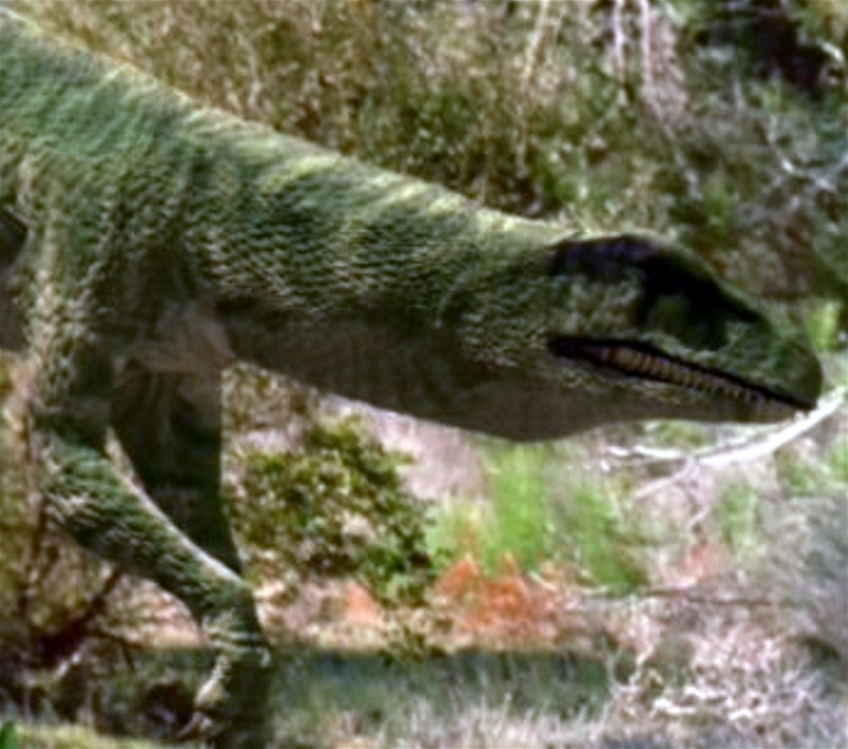Walking with Dinosaurs (partially lost pitch pilot of BBC documentary series; 1997): Difference between revisions
m (Edited a spelling mistake.) |
mNo edit summary |
||
| Line 1: | Line 1: | ||
{{NeedingWork|lack of references}} | {{NeedingWork|lack of references}} | ||
{{InfoboxLost | {{InfoboxLost | ||
|title=<center>Walking | |title=<center>Walking with Dinosaurs (pilot)</center> | ||
|image=PilotEustreptospondylus.png | |image=PilotEustreptospondylus.png | ||
|imagecaption=The pilot version of the Eustreptospondylus. | |imagecaption=The pilot version of the Eustreptospondylus. | ||
|status=<span style="color:orange;">'''Partially Found'''</span> | |status=<span style="color:orange;">'''Partially Found'''</span> | ||
}} | }} | ||
'''Tim Haines created the pilot for ''Walking | '''Tim Haines created the pilot for ''Walking with Dinosaurs'' in 1996 to sell the show to the BBC''', as the BBC wanted a television series centered around dinosaurs following the success of ''Jurassic Park''. Partial clips of the pilot were featured in the ''Trilogy of Life'' (2005) documentary, which was a featurette on the ''Walking with Monsters'' DVD. This would be the first and only time clips of the pilot were released. | ||
==History and Production== | ==History and Production== | ||
In 1996, Tim Haines pitched ''Walking | In 1996, Tim Haines pitched ''Walking with Dinosaurs'' to the BBC. The BBC allowed Haines to create a short film that would be a proof-of-concept and gave him a budget to do so. The initial runtime was intended to be two minutes but the pilot ended up becoming six minutes long. | ||
To find a filming location, Haines talked with an unknown paleobotanist and they determined that the best place to film would be coastal forests in the Mediterranian because its environment matched the time period and setting the film was intended to take place in (Oxford Clay Formation during the Late Jurassic). | To find a filming location, Haines talked with an unknown paleobotanist and they determined that the best place to film would be coastal forests in the Mediterranian because its environment matched the time period and setting the film was intended to take place in (Oxford Clay Formation during the Late Jurassic). | ||
| Line 15: | Line 15: | ||
Haines would then ask Mike Milne of the Framestore company (which produced computer animations), to create high-quality computer-animated dinosaurs on a television budget for a television program. Milne initially declined the offer but later agreed to help Haines. Haines went on to the filming location and, to help Milne and his team determine where to insert the computer-animated dinosaurs, made dinosaur tracks with prosthetic boots along with using the "ball-and-stick" technique. Although it is likely that most of the effects were made with CGI, practical effects were also used. The most notable use out of the brief clips available is a scene that includes an animatronic Liopleurodon which is stranded onshore. | Haines would then ask Mike Milne of the Framestore company (which produced computer animations), to create high-quality computer-animated dinosaurs on a television budget for a television program. Milne initially declined the offer but later agreed to help Haines. Haines went on to the filming location and, to help Milne and his team determine where to insert the computer-animated dinosaurs, made dinosaur tracks with prosthetic boots along with using the "ball-and-stick" technique. Although it is likely that most of the effects were made with CGI, practical effects were also used. The most notable use out of the brief clips available is a scene that includes an animatronic Liopleurodon which is stranded onshore. | ||
The BBC would buy the show and ''Walking | The BBC would buy the show and ''Walking with Dinosaurs'' was turned into a docuseries, however, the pilot remained unreleased until 2005. To coincide with the release of ''Walking with Monsters'', the documentary ''Trilogy of Life'', which gave a behind-the-scenes look at ''Walking with Dinosaurs'', ''Walking with Beasts'', and ''Walking with Monsters'' was a featurette on the DVD. A brief segment in ''Trilogy of Life'' featured short clips of the ''Walking with Dinosaurs'' pilot along with Tim Haines explaining how it was made. However, this is the only instance of the pilot that has ever been released and most of it remains unavailable. | ||
==Synopsis== | ==Synopsis== | ||
| Line 29: | Line 29: | ||
}} | }} | ||
==References== | ==References== | ||
<ref>[https://tetzoo.com/blog/2021/6/23/reminiscing-about-walking-with-dinosaurs-part-1 Naish, Daren (2021). Reminiscing About Walking | <ref>[https://tetzoo.com/blog/2021/6/23/reminiscing-about-walking-with-dinosaurs-part-1 Naish, Daren (2021). Reminiscing About Walking with Dinosaurs, Part 1] Retrieved 18 Aug '21</ref> | ||
<ref>[https://dinosaurlive.com/about/the-making-of/ Making of | Walking | <ref>[https://dinosaurlive.com/about/the-making-of/ Making of | Walking with Dinosaurs] Retrieved 18 Aug '21</ref> | ||
[[Category:Lost TV]] | [[Category:Lost TV]] | ||
[[Category:Partially found media]] | [[Category:Partially found media]] | ||
Revision as of 00:20, 19 August 2021
Tim Haines created the pilot for Walking with Dinosaurs in 1996 to sell the show to the BBC, as the BBC wanted a television series centered around dinosaurs following the success of Jurassic Park. Partial clips of the pilot were featured in the Trilogy of Life (2005) documentary, which was a featurette on the Walking with Monsters DVD. This would be the first and only time clips of the pilot were released.
History and Production
In 1996, Tim Haines pitched Walking with Dinosaurs to the BBC. The BBC allowed Haines to create a short film that would be a proof-of-concept and gave him a budget to do so. The initial runtime was intended to be two minutes but the pilot ended up becoming six minutes long.
To find a filming location, Haines talked with an unknown paleobotanist and they determined that the best place to film would be coastal forests in the Mediterranian because its environment matched the time period and setting the film was intended to take place in (Oxford Clay Formation during the Late Jurassic).
Haines would then ask Mike Milne of the Framestore company (which produced computer animations), to create high-quality computer-animated dinosaurs on a television budget for a television program. Milne initially declined the offer but later agreed to help Haines. Haines went on to the filming location and, to help Milne and his team determine where to insert the computer-animated dinosaurs, made dinosaur tracks with prosthetic boots along with using the "ball-and-stick" technique. Although it is likely that most of the effects were made with CGI, practical effects were also used. The most notable use out of the brief clips available is a scene that includes an animatronic Liopleurodon which is stranded onshore.
The BBC would buy the show and Walking with Dinosaurs was turned into a docuseries, however, the pilot remained unreleased until 2005. To coincide with the release of Walking with Monsters, the documentary Trilogy of Life, which gave a behind-the-scenes look at Walking with Dinosaurs, Walking with Beasts, and Walking with Monsters was a featurette on the DVD. A brief segment in Trilogy of Life featured short clips of the Walking with Dinosaurs pilot along with Tim Haines explaining how it was made. However, this is the only instance of the pilot that has ever been released and most of it remains unavailable.
Synopsis
Similar to the released show, the pilot is in a nature documentary format where dinosaurs are shown interacting, hunting, and eating. The animals featured in the pilot are Eustreptospondylus, Cetiosaurus, Scaphognathus, and Liopleurodon. We see Scaphognathus flying over the coastline to feed on fish below the water. Meanwhile, a Eustreptospondylus is hunting in the foliage, using its coloration to camouflage. The Eustreptospondylus then comes across a herd of Cetiosaurus who are browsing on the treetops. In the waters, a Liopleurodon is seen just below the surface. It is later beached on the shoreline.
Many aspects of the pilot were later used in the third episode "Cruel Sea" of the released show. Eustreptospondylus and Liopleurodon were used in the final version while Cetiosaurus and Scaphognathus were cut. The Liopleurodon would end up getting beached in the final version much like how it does in the pilot. The same time period and setting would also be used in "Cruel Sea."
Gallery
References
- ↑ Naish, Daren (2021). Reminiscing About Walking with Dinosaurs, Part 1 Retrieved 18 Aug '21
- ↑ Making of | Walking with Dinosaurs Retrieved 18 Aug '21

